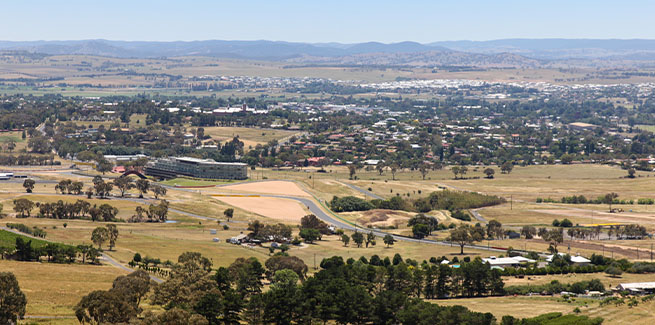Kim Houghton, chief economist from think tank Regional Australia Institute appeared last week before the House of Representatives standing committee on tax and revenue, for its ongoing inquiry into housing affordability.
He warned MPs that the pandemic and remote working have fired up waves of mass migration out of the capital cities, the property supply in many regions have been blocked by lending processes and rising construction costs.
“One of the key issues that we find in our more inland places and smaller markets – not high growth population centres but the ones inland – is that those markets are stalled because of the combination of banks requiring quite large deposits because there are very few transactions for them to base their market evaluations on, coupled with the build costs being much higher than the existing median house price,” Dr Houghton said.
He elaborated that the banks charge a risk premium in markets where there are small numbers of transactions – while the cost of building has proved so prohibitive, Mount Isa for example has seen one house built in the last 12 months.
A survey by Regional Australia Institute from last year had shown one in five capital city residents were looking to make a regional move in the next two to three years.
Further, Dr Houghton noted there had been a boost in dwelling approvals across the regions, but it has been tied to HomeBuilder, repeating past jumps that were also linked to government stimulus.
“When that finished in March, these dwelling approvals have dropped. There are some underlying challenges there that need be addressed,” Dr Houghton said.
Thus, the body has recommended the formation of a regional new home guarantee, along the lines of the government’s recent home-ownership grants for first home buyers and for single parents.
Regional Australia Institute has said that the market has failed at supplying the right mix of dwellings, with Dr Houghton referring to a “significant undersupply – the missing middle – of medium density in regional Australia”.
Recent research from the body showed demand is evenly split between units and detached housing in Western Queensland.
“We know that in those markets the consumers and residents want that mix of housing. Yet, what the development sector is providing is typically the easy win, which is the outer suburban peripheral growth, and we’re not seeing that medium density, even in these growth markets,” Dr Hougton said.
“That would bring the price points down and slow the rate of price growth. But, for some reason, those signals aren’t getting through to the developers.
“So that’s the market failure in those markets, in my view.”
Meanwhile, City of Sydney councillor Linda Scott, who is the president for the Australian Local Government Association, told the committee that mayors across regional NSW had told her they were experiencing a rise in homelessness in their communities.
“This a new phenomenon in many of our regional communities,” she said.
“We know that in some regional areas there is high growth and they’re growing faster than anticipated due to recent changes in migration patterns. However, in other communities there simply isn’t enough affordable housing for key workers; sadly, in others, due to high housing costs, an increasing number of people are sleeping rough.”
However, the councillor stated simply raising housing supply would not translate to reduced prices or increase the amount of affordable options, calling it a “multifactorial problem”.
“Issues such as changes to recent migration patterns, cheap finance and labour, and material shortages in the construction sector are all currently having an impact on the supply of housing,” Ms Scott said.
Similarly, Townsville mayor Jenny Hill expressed concerns around housing affordability in North Queensland, stating insurance premiums for building and contents in the region are much higher than in the south of the state.
“More recently, the property sector locally has advised of sector-wide difficulties in acquiring sufficiently skilled labour to keep up with demand, as well as a shortage of supply of materials,” Ms Hill said.
“Costs of subcontracting services like fencing, concreting and plumbing have all skyrocketed during the COVID period, with some prices for services locally up by 400 per cent since the beginning of 2020. We believe that these supply chains will be made much harder by the increasing push in the south-east corner, particularly around major projects like the Olympics.”
Union rings alarm on house price surge
Retail, fast food and warehousing workers union SDA told the committee on Wednesday (10 November) that low and middle-income earners are at risk of permanent exclusion from the housing market.
The body has called for a national affordable housing agency, with a mandate to ensure secure and affordable ownership and rental options for all Australians.
Gerard Dwyer, national secretary of the SDA commented home ownership will continue to fall unless policy solutions are found.
“With the median house price in Sydney now 15 times average full time wages, compared with five times in 1981, housing affordability for workers on low wages is a constant struggle, a fact made more stark given the wage for a fulltime retail worker is $44 thousand, less than half the average fulltime wage,” Mr Dwyer asserted.
“This is now a regional problem, too. The significant proportion of SDA members who reside in regional Australia are now having to deal with the pressure of a housing market that is marching away from lower paid workers.”
Around 64 per cent of regional renters in an SDA survey had cited high rental and housing prices as main concern for the future health and liveability of their local area.
However, the union has criticised first home-owner schemes and suggestions for early superannuation withdrawals to fund housing deposits.
Instead, it has called for build-to-rent and rent-to-buy solutions.
[Related: APRA runs through lending control toolkit]

